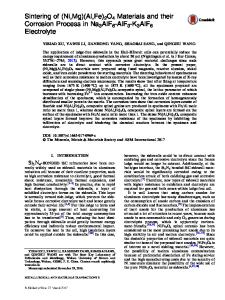Fabrication of ALF 3 -Based Glass Fibers
- PDF / 840,274 Bytes
- 6 Pages / 414.72 x 648 pts Page_size
- 36 Downloads / 329 Views
FABRICATION OF ALF 3 -BASED GLASS FIBERS Mahmoud R.Shahriari, Tariq Iqbal,Paul R. Foy, Steve J. Saggese, and G.H.Sigel, Jr. Rutgers University, Fiber Optic Materials Research Program, Piscataway, NJ
Abstract : Several glass systems based on AIF 3 have been synthesized and fabricated into preforms by controlled melting and rotational casting. High optical quality preforms have been drawn into fibers using a specially modified drawing facility. The drawing tower is enclosed with a vertical glove box in which the levels of both moisture and oxygen are kept below 1 ppm during the drawing. The AIF 3 -based fibers have shown dramatically superior chemical durability relative to the ZrF 4 -based glass fibers. Selected optical, mechanical and thermal properties of these fibers will be presented. AIF 3 -based glass fibers offer interesting opportunities for short range applications in the 2-4 micron region of the infrared such as sensing, remote spectroscopy and laser power delivery. Introduction Since the discovery of fluoride glasses, the main emphasis has centered on the fluorozirconate glass systems for ultra low loss fibers for long range communications systems. Many additional applications
now appear to be emerging for fluoride glasses particularly in short range systems such as remote sensing and laser power transmission where ultra -low loss is not required. Fluorozirconate glasses are typically poor in chemical durability and mechanical strength [1-2]. therefore there is a need for the development of new IR transmitting glasses for optical fibers with enhanced chemical durability and strength for practical uses. AIF 3 -based glasses have shown superior chemical durability compared to the well-known ZrF 4 -based glasses [3-4]. In this work AIF 3 -based glasses have been drawn into fibers for the first time from preforms prepared by the rotational casting technique. Both the core and cladding are made from AIF 3 -based glass compositions and the preforms have been successfully drawn into long fibers under extremely low moisture levels. Both the processing as well as some of the thermal, optical and mechanical properties of these new fibers will be discussed and compared to those of ZrF 4 -based glass fibers.
Mat. Res. Soc. Symp. Proc. Vol. 172. ©1990 Materials Research Society
164
Glass compositions : The glass system considered as a base composition for both the core and the cladding contains the following components in order of decreasing molar composition, AIF 3 -CaF 2 -SrF 2 -BaF 2 -ZrF 2 -YF 3 -NaF. Similar compositions studied originally by HOYA corporation showed enhanced chemical durability and mechanical strength for bulk glasses[4-5]. A base glass was chosen as the cladding composition and for the core composition about 2.5% of the divalent components such as BaF 2 , CaF 2 , and SrF2 were replaced with PbF 2 in order to increase the refractive index. The core and cladding compositions are given in Table 1. Some of the important properties of the core and clad glasses are given in Table 2. Figure 1. sh
Data Loading...










